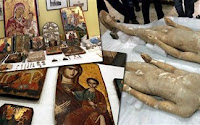
People investigating the case of the armed robbery at the Museum of Ancient Olympia say that the 65 stolen artifacts have possibly crossed Greek borders.
According to police sources, the case of Ancient Olympia was a made-to-order theft, because the thieves, after having stolen the 65 artifacts, were trying to find another two exhibits that were not being shown.
There are many cases of antiquities thefts in Greece and in most of the cases the artifacts end up in international galleries or in private galleries abroad.
Illicit trade in Greece is of major concern and goes beyond the field of antiquities. The Greek country’s ecclesiastical heritage has been dealt a heavy blow as well.
Cases of Ecclesiastical Heritage Thefts
In the past, Scotland Yard identified the alleged mastermind behind a ring that had been stealing religious icons from churches and monasteries in Epirus and Thessaly which subsequently ended up at European auction houses. The information that led to the ring leader’s identification was provided by a London gallery following the online identification of six Byzantine icons that the gallery was planning to sell.
Besides the aforementioned relics, the London gallery has also handed over another 10 icons to the Greek Embassy in the British capital which have also been identified through photographs as having been stolen from monasteries in Epirus and Western Macedonia.
Moreover, two icons and one cross were stolen from a Church in Serres in the past, and the offenders were trying to resell the items but police authorities prevented them.
Famous Antiquities Smuggling Cases in Greece
Two ancient ‘Kouros’ statues named the ‘Kouri [plural] of Tenea’ were unearthed by antiquities smugglers during an illegal excavation in the Klenies district of southern Corinth prefecture. After the police arrested the smugglers in May 2010, the statues were sent to the National Archaeological Museum in Athens for restoration. According to police, the smugglers had demanded 10 million euros for the statues. The statues are safely located at the archaeological museum of Corinth.
In 2006, Greek police announced their largest ever discovery of illegal antiquities, on April 13 at a villa on the tiny Aegean island of Schinoussa, south of Naxos.
According to archaeologists inventorying the collection, it contained 280 items dating to many periods and from around the Mediterranean, some hidden and some openly used as decorations. A 30-metre-square chapel had been built on the six-acre site, constructed of ancient architectural fragments from various eras. Other items were a headless Roman statue of Aphrodite, a carved marble sarcophagus, three marble busts and two granite sphinxes.
The villa belonged to Dimitra Papadimitriou of the wealthy shipping family, but was reported to had been owned previously by London dealer Robin Symes and his business partner, the late Christos Michailidis, Papadimitriou’s brother.
Greek media immediately began to speculate about a link with Greek items in the J. Paul Getty Museum, Los Angeles. Culture Minister Giorgos Voulgarakis said there was no evidence for this, but seals and packaging found on the island showed signs of commercial trafficking. Documentation found during the raid also indicated that many of the items had been purchased at Sotheby’s or Christie’s between 2001 and 2005, although none had been declared on entry into Greece.
See all the latest news from Greece and the world at Greekreporter.com. Contact our newsroom to report an update or send your story, photos and videos. Follow GR on Google News and subscribe here to our daily email!



